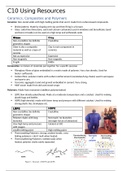Summary
Summary C10 Using Resources
- Course
- Institution
A complete summarised group of documents complete for GCSE Chemistry AQA 9-1. To make these Summaries I used 3 sources: The CGP revision guide, My GCSE Science Videos and Free science lessons videos. I achieved a 9 in GCSE AQA Triple Chemistry.
[Show more]



